Nikon Coolpix P7000 Review
Nikon Coolpix P7000 Usability - How easy is it to use?
Broadly speaking, the Nikon Coolpix P7000 is a very well-designed camera. It wears its advanced features on the outside, with loads of buttons and dials, making using those features efficient and enjoyable to use. At the same time, the automatic mode (P) and scene modes are just as easy to use as with any point-and-shoot camera. While the camera is operated, the P7000 displays visual cues to show what is happening.
Despite being one of the larger compacts, its back is covered with buttons other than a rubber-coated depression to secure your thumb. This is complemented by a small rubber grip at the front of the camera. It is therefore easy to hold this digital camera securely with one hand. At 360g it has a good weight without feeling heavy. Nikon provides a neck-strap which is attached by eyelets on either side of the camera. One can easily use a wrist-strap instead, which we preferred during the review period as it made it easier to take the camera in and out of coat pockets. Certainly given its size, the P7000 will not fit most pant pockets.
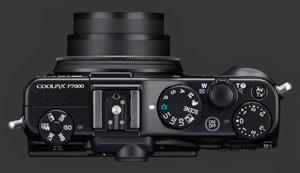
The top panel holds, from left-to-right, the quick-menu dial-and-button, the hot-shoe, the mode-dial, the power-button, the shutter-release surrounded by the zoom controller, the exposure-compensation dial and the customizable Av/TV button. Both EC and quick-menu dial are designed to be operated from the back, so they protrude slightly. They have good click-stops, so they are not likely to be changed accidentally.
The quick-menu dial has a designed introduced years ago by Konica-Minolta and not seen much since. It is operated by first rotating it to a desired parameter and then pressing the button in its center to activate the menu for that parameter. This is faster than scrolling through menus looking for an option but Nikon's implementation is not so quick either. It takes about one second for the menu to actually appear. It would be much better, as in the original implementation, to have a heads-up view to change parameters directly without loosing the image preview. It is better than not having this button but we are saying it can be improved further.
Skipping over the standard hot-shoe, we arrive at the mode-dial which works just as expected. The camera changes modes rapidly and there are click-stops that make it rather hard to unintentionally turn it. Note the presence of a Movie-Mode position which makes recording videos much more usable than on a lot of recent digital cameras. Next is a small power-button which is level with the top camera surface. It lights up momentarily when powering on and then flashes when sleep mode automatically engages after a delay of inactivity. It works just-right, no complaints here!
The shutter-release has some resistance to the touch and goes smoothly to the halfway point. The full-press is a hair deeper, making taking the shot after pre-focusing very quick. The rotating zoom controller surrounding the shutter is quick and responsive. It normally moves the lens between fine-steps. Optionally, one can hold on the the Fn button at the front of the camera, and have the zoom jump through a set of predefined steps taken from traditional 35mm camera prime lenses.
Further right is the exposure-compensation dial. This one dials EC in 1/3 EV steps and works in most camera modes except for a few scene-modes. Thankfully it does work in Panorama-Assist mode. When the dial is positioned anywhere other than zero, a small orange light turns on to remind the user that exposure-compensation is in effect. This is simply a great design. The only limitation is that 1/2 EV stops are not available on this camera as the dial has hard clicks for 1/3 EV stops.
The last button on top of the camera is the oddly named Av/Tv button. Its default function is to reverse the operation of both control-dials. This is a useful feature which is generally placed in the setup menu because it should be rarely changed. Users learn the camera a certain way and stick with it, particularly since this camera has two control-dials. A quick note regarding this default feature is that it does not seem to always remember the last selection, at least not in an intuitive way. Luckily, Nikon offers 4 other functionality for this button: Virtual horizon, Toggle histogram, Toggle grid and Built-in ND-filter. The Virtual HorizonNikon's term for a 1-axis digital-level is intrusive to view a subject, so using the Av/Tv button as a toggle for it is a great option. You can also program the display button for something similar but you need to cycle through the display-off mode which is annoying, better put it on Av/Tv. The other interesting option here is the 3-stop ND filter. When experimenting with photographs that show motion-blur, it is a valuable tool.
The front of the camera is comparatively bare. There is the autofocus assist-lamp, two holes which form the stereo microphone, a IR receptor, an optical tunnel viewfinder and two buttons. The optical viewfinder zooms along with the lens which is impressive considering its 7X range. Less impressive is a rather poor 64% coverage, so we would reserve its use for emergencies or when you want to pretend to be taking a picture so that no one bothers you. The unmarked button is used to release a ring around the lens barrel. Removing the ring reveals a bayonet thread used to attach the optional wide-angle adapter which gives a 21mm-equivalent field-of-view. The other button is marked Fn. Its functionality is a little odd and is definitely an under-used button. Basically, when pressed while also pressing the shutter, the Fn button temporarily resets one parameter. This can be ISO sensitivity, White-balance, Picture-Control, Active D-Lighting or Metering. It can also toggle the file-format between JPEG and RAW. It would be better if it could be used with the control-dials as well, to give access to something like the ISO and WB setting much faster than with the quick-menu. Still, as we said earlier, most cameras do not even have such a button.
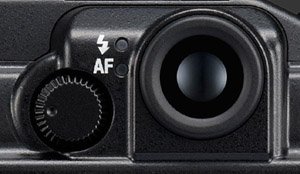 There is a lot going on at the back. A round button is used to release the built-in popup flash. When the flash is up it does nothing. We would suggest to Nikon to make it apply flash-compensation when used with one of the control-dials. Push the flash down to bring it back it. The unmarked circular dial next to the viewfinder applies diopter-correction. A small lamp above it shows when AF is locked or the flash is charging. Below these is the large 3" LCD which is very sharp and has 920K pixels. It refreshed quickly enough and has an anti-reflective coating to improve visibility. In bright light, it does get more difficult to see than others we have seen and that is probably why the optical viewfinder is there. There are two major criticism with the LCD, first it only shows 94% coverage which is below its competition's 100% coverage. Second, the display is not exposure-priority. Dialing in EC alters the histogram as it should but not changing exposure parameters like aperture and shutter-speed. Worst is that the live-histogram is computed on the incorrect LCD display, so even in cases of severe under-exposure you would not know it. Neither the histogram or LCD view is updated when these parameters are changed. We really hope Nikon can correct this via firmware update.
There is a lot going on at the back. A round button is used to release the built-in popup flash. When the flash is up it does nothing. We would suggest to Nikon to make it apply flash-compensation when used with one of the control-dials. Push the flash down to bring it back it. The unmarked circular dial next to the viewfinder applies diopter-correction. A small lamp above it shows when AF is locked or the flash is charging. Below these is the large 3" LCD which is very sharp and has 920K pixels. It refreshed quickly enough and has an anti-reflective coating to improve visibility. In bright light, it does get more difficult to see than others we have seen and that is probably why the optical viewfinder is there. There are two major criticism with the LCD, first it only shows 94% coverage which is below its competition's 100% coverage. Second, the display is not exposure-priority. Dialing in EC alters the histogram as it should but not changing exposure parameters like aperture and shutter-speed. Worst is that the live-histogram is computed on the incorrect LCD display, so even in cases of severe under-exposure you would not know it. Neither the histogram or LCD view is updated when these parameters are changed. We really hope Nikon can correct this via firmware update.
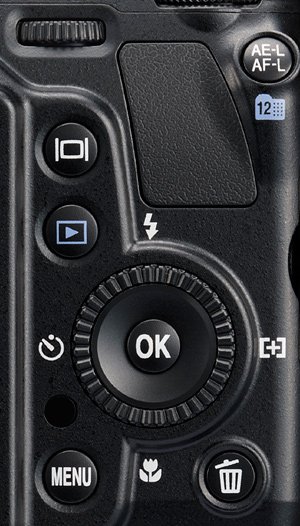 To the right of the LCD, the P7000 counts no less than 6 buttons and 2 dials. Both dials are used to modify parameters or scroll through menu options. The upper dial is easily reachable without shifting your grip of the camera. This is not the case with the lower dial due to its position. Opposite from the upper dial is the AE-L/AF-L button which works when held down. Directly below the upper-dial is the display button which cycles the LCD through full-info, no-info or off modes. In both full-info and no-info modes, setup options can toggle the appearance of the virtual horizon, the live-histogram or the framing-grip.
To the right of the LCD, the P7000 counts no less than 6 buttons and 2 dials. Both dials are used to modify parameters or scroll through menu options. The upper dial is easily reachable without shifting your grip of the camera. This is not the case with the lower dial due to its position. Opposite from the upper dial is the AE-L/AF-L button which works when held down. Directly below the upper-dial is the display button which cycles the LCD through full-info, no-info or off modes. In both full-info and no-info modes, setup options can toggle the appearance of the virtual horizon, the live-histogram or the framing-grip.
There is also a standard button which enters and exits playback mode. The camera is almost shooting-priority so tapping the shutter-release goes back to shooting mode except on confirmation dialogs. Jumping over the 4-way controller the rear IR reception which sits just above the Menu button. No explanation needed for the menu button. Also near the bottom of the camera is the Delete button. It works in playback mode and in still mode where it prompts to delete the last shot taken.
The central piece is the combined lower-dial and 4-way controller. This particular control provides access to quite a few options in addition to navigating menus and changing exposure-parameters. The Up direction changes the flash mode when the flash is actually up. In this case the options are: Auto, Auto with Redeye reduction, Fill-flash, Manual flash, Slow-sync and Rear-sync. In manual-flash mode, the power can be set between 1/64th and full power. Note that the camera menu can disable the camera from using the built-in flash. In this case, the flash mode of an external-flash can be set between Auto, Auto with Redeye, Off, Fill, Slow-Sync or Rear-Sync. This digital camera is smart enough to skip over the options not supported by the add-on flash.
The right direction controls focus point-selection. You can choose from Face-Detect, Auto, Manual, Center and Subject-Tracking. In Manual mode, you can move the focus point to 99 positions using the directional buttons. For Center, 3 sizes are available: wide, normal and spot. The down direction controls the focus range. You can select between Normal, Macro, Infinity and Manual. The Infinity option locks the focus to infinity. This is useful for shooting landscapes in very low-light or when shooting from a moving vehicle when the camera cannot focus normally. Manual focus lets you set the distance using the up and down arrows. The camera makes it easier to select a distance by magnifying the center of the frame, although we did not find that view sharp enough to set focus with sufficient accuracy. One neat feature here is that the manual focus can be primed using the right away which causes autofocus to set the initial focus distance.
Only the left direction is missing. That one is used for the self-timer. There are actually seven options there. Two are regular timers at 2s and 10s, respectively. Both these timers reset after each use, which gets annoying when shooting from a tripod. There are also the same timers available for use with the optional infrared remote, plus an option of immediate release using the remote. Lastly one can set the self-timer off or enable the smile-timer. The smile-timer takes a picture automatically when someone smiling is detected.
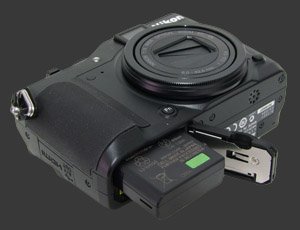 The bottom of the camera features a metal tripod mount. It is not inline with the center of the lens or the camera center. A sturdy door covers the battery and memory-card compartment. As one would expect from this type of camera, the entire body actually feels quite solid. There are plastic flaps on both sides of the camera. One covers the microphone input jack, the other the connectors for HDMI and combined USB & A/V output.
The bottom of the camera features a metal tripod mount. It is not inline with the center of the lens or the camera center. A sturdy door covers the battery and memory-card compartment. As one would expect from this type of camera, the entire body actually feels quite solid. There are plastic flaps on both sides of the camera. One covers the microphone input jack, the other the connectors for HDMI and combined USB & A/V output.
Overall, this Coolpix features one of the most usable manual controls among compact digital cameras. Although certain potential improvements were pointed out, the only usability issue is the inaccuracy of the display in terms of exposure, histogram and coverage. We discuss metering in the next page of this review but we should say that results are reliable enough that not very few exposure errors should occur in any of the automatic modes.
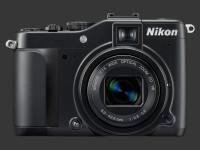 |
Please Support Neocamera
All information on Neocamera is provided free of charge yet running this website is a huge endeavor. Purchases made via affiliate links found throughout the site help keep it running and up-to-date. There is no additional cost to you, so please consider buying via these links to our affilates:
If you found any information on this site valuable and did not purchase via our affiliate links, please considering donating via PayPal:
Any amount will be greatly appreaciated. Thank you for your support!
Nikon P7000 Highlights

Sensor-Size: 8 x 6mm

Actual size when viewed at 100 DPI
| 10 Megapixels Fixed Lens | ISO 100-6400 |
| 7.1X Wide Optical Zoom | Shutter 1/4000-60s |
| Built-in Stabilization | Full manual controls, including Manual Focus |
| 1 Axis Digital Level | Custom white-balance with 2 axis fine-tuning |
| 1.3 FPS Drive, 45 Images | Spot-Metering |
| 1280x720 @ 24 FPS Video Recording | Hot-Shoe |
| 3" LCD 920K Pixels | Stereo audio input |
| Lithium-Ion Battery | |
| Secure Digital Extended Capacity, Internal Memory |
Updates
2024.04.03

Fujifilm X-T5 Review
Newest Fujifilm flagship boasting a 40 MP APS-C sensor, 5-axis IBIS with 7-stop efficiency, 15 FPS continuous drive, 6.2K Video capture, dual control-dials and dual SDXC UHS-II slots in a sturdy weatherproof and freezeproof body.
2023.11.20

Best Digital Cameras of 2023
Find out which are the Best Digital Cameras of 2023. All the new Mirrorless Digital Cameras from entry-level to high-end professional.
2023.07.10

Fujifilm X-H2 Review
40 Megapixels APS-C Hybrid Mirrorless Digital Camera with 7-stop IBIS. Fastest shutter ever and 8K video capture. Large builtin EVF with 0.8X magnification and 5.8 MP, plus an Eye-Start Sensor. Packed with features and large number of controls in a weatherproof and freezeproof body.
2023.05.07

Sony FE 20-70mm F/4G Review
Review of the unique Sony FE 20-70mm F/4G lens. The optical zoom of this lens spans ultra-wide-angle and medium focal-length coverage, making it one of the most versatile Full-Frame lenses on the market.
2023.01.15

Huion Inspiroy Dial 2 Review
Review of the Huion Inspiroy Dial 2 tablet, a medium sized drawing surface with dual dials and customizable buttons. Connects via USB-C or Bluetooth 5.0 with Windows, Linux and Android support.
2022.12.08

How to Pack for a Photo Trip
Find out how to pack for a travel photography trip, carry your gear safely while meeting airline regulations.
2022.11.13

Best Digital Cameras of 2022
The best digital cameras of 2022. A short list of the most outstanding models in their respective categories. Choose one for yourself or as a gift.
2022.09.21

Pentax DA* 60-250mm F/4 SDM Review
Review of the Pentax DA* 60-250mm F/4 SDM, the constant-aperture telephoto zoom with the highest zoom-ratio on the market.
2022.09.20

Pentax DA* 50-135mm F/2.8 SDM Review
Review of the Pentax DA* 50-135mm F/2.8 SDM, the lightest professional telephoto zoom native to the K-mount.
2022.09.10

Pentax DA* 11-18mm F/2.8 DC AW Review
Review of the Pentax DA* 11-18mm F/2.8 DC AW, the widest professional ultra-wide zoom native to the K-mount.
2021.11.24

50 Gifts Under $50 For Photographers in 2021
50 Gifts photographers will love. All for under $50 USD. 2021 Edition.
2021.11.17

Best Digital Cameras for 2021
Neocamera shows which are the very best Digital Cameras for 2021 in every category: Mirrorless, DSLR, Premium Compact, Ultra-Zoom and Rugged.












